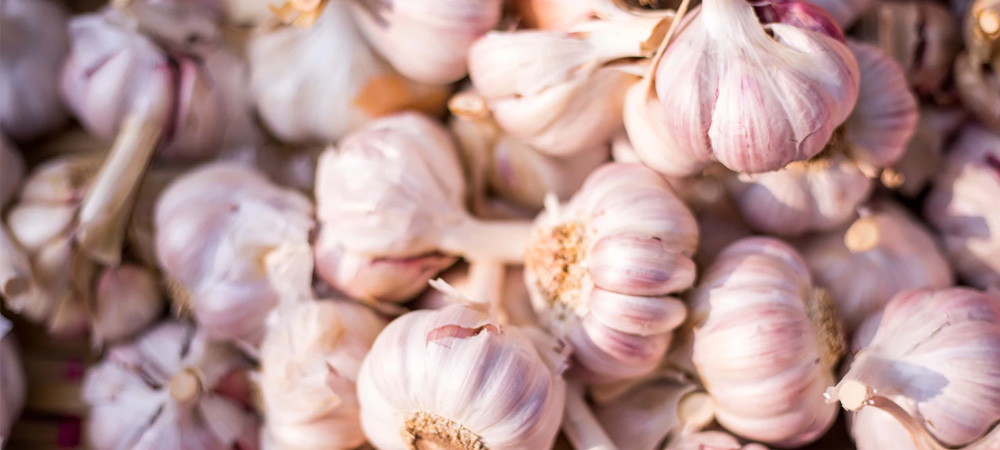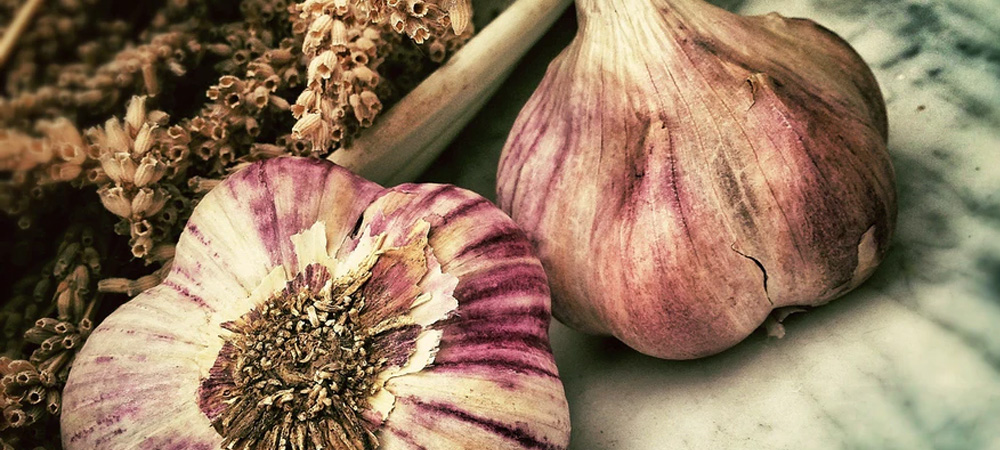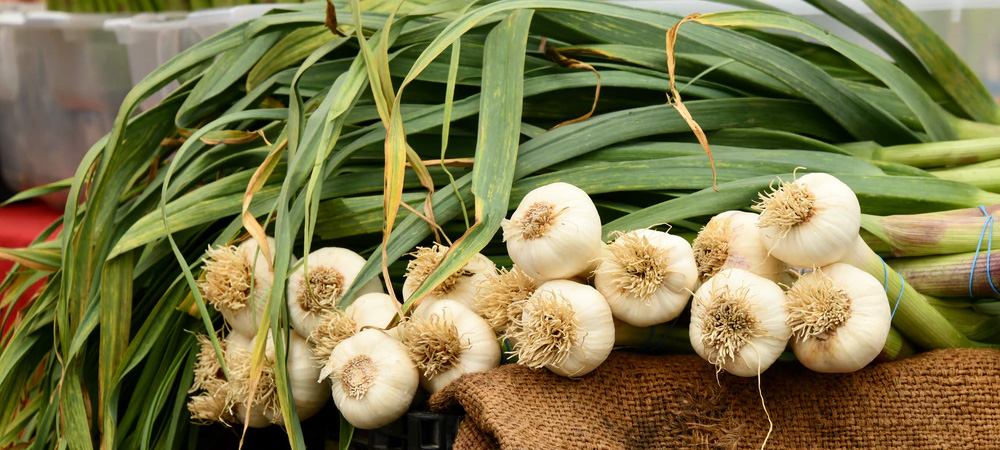How to Grow Garlic in a Greenhouse

Winter is called winter for a reason – you simply can’t grow everything you would grow in the spring, summer, or even the autumn. For most plants, it is a time of dormancy and regrouping for the springtime to come.
But that’s not true of all of them!
Even if you have an unheated greenhouse, and autumn is fast approaching, there are some options that are not only practical and easy, but they’re a welcome addition to the plate or pot as well. A top contender? Garlic.
Garlic almost never sets seed, preferring to propagate by vegetative propagation instead. This is a very reliable method of producing more garlic plants – and is even a great educational opportunity for getting children and newcomers interested in the miracle of gardening.
The process is easy, and interesting to watch. Take a bulb of ‘seed garlic’ and split the bulb into cloves (we recommend buying a seed garlic that has been selected for good garden performance, and is more likely to be virus free). Each clove divides and grows inside the paper-like covering, eventually producing several cloves of its own. The leaves will grow up high during development and then die back around the time the bulb is reaching maturity below the surface.
Related read: What vegetables to grow in a greenhouse
Health Benefits of Garlic
Garlic has long been considered a health-giving plant, even inspiring legends about its ability to fend off evil creatures like vampires! It has been under cultivation for as long as 20,000 years, and used as an antifungal, antiseptic, and immune-boosting home remedy for as far back as we have information on it. It has been used to treat everything from diarrhoea to athlete’s foot and has even been applied directly to wounds to discourage infection. Some even claim that it has anticancer properties. Less dramatic, but still a great relief, it has also been used to repel mosquitoes and other annoying insects from plants and even our own bodies.
Garlic is Easy to Grow
Garlic is so easy to grow, it’s better to think of it as hard to keep from growing. Though cloves from the supermarket sometimes thrive here, they are more often shipped in from distant countries and warmer climates and may not do well in the rainy, sometimes gloomy British climate. For most reliable results, pick up a garden variety from a local supplier.
Need a new greenhouse? Click here.

How to Plant Garlic
Garlic can be planted in the winter, providing the soil it goes into isn’t frozen, and it can thrive even in an unheated greenhouse. Plant individual cloves into pots of good compost and pop them into the greenhouse. They will be ready for transfer into the soil as soon as it becomes workable outside.
Just follow these 4 simple steps:
- Divide – Starting with a fresh bulb, break each clove away from the others, being careful to keep the base intact on the bottom of each one. If the base is broken or missing, the clove won’t develop. Keep the husk (the papery part) on the clove, as it needs this protection during early development.
- Plant – Push each clove in the soil, until the bottom is about 5cm (two inches) from the surface. The tip should be pointing upward and the flat base downward. There should be about 20cm (8 inches) of clearance all around each clove.
- Cover – Once they are in the ground, cover the bulbs with a mulch. Something organic, like dry leaves or hay is a good choice. This layer will insulate the soil, keeping it cool and moist while the cloves begin their growth.
- Feed – Fertilise your future crop several times, just before the bulbs start to swell. You will be able to identify this stage of growth by the yellowing of the leaves above ground.
If you only want a smaller growing space, you could use a cold frame for this instead.
Other Garlic Growing Tips
Plant the biggest cloves you have access to. Smaller cloves need as much space as the larger ones do, but they (not surprisingly) tend to produce much smaller bulbs too, so your yield is smaller for the same amount of space.
Once you have your first crop, set aside the largest and most impressive of the bulbs for replanting.
The best yields occur in areas that get a lot of regular sunlight. Garlic can take direct sunlight and a fair amount of heat too.
Tilling the ground before planting is the best way to go with garlic, as it grows best on clear ground that is free of weeds and other competition. Another option is to grow in trays inside your greenhouse.
Plant your cloves within 24 hours of separating them. This prevents over-drying, and the roots will set more quickly and reliably.
Avoid using cloves you purchase from the grocery store. Though the quality may be very good, the source plants may be grown to thrive in a very different climate than that of the British Isles! Your best bet is to purchase something from a local provider of seed-garlic. Need another reason? Some grocery providers treat their garlic for longer shelf-life, which means longer times for setting root, and more common failure altogether.
Cut off the shoots once the garlic begins to flower, so that the plant can redirect its energy and resources into producing larger bulbs.
Common Issues
Too much competition. Make sure the ground is clear of weeds.
White rot. Rotating crops can help to prevent this fungal infestation.
Bulb mites. These are more of a nuisance than a crop-killer, but can be prevented using crop rotation.
Birds. Some species of birds can sometimes feed on seedlings and shoots. Grow in a greenhouse if this is a serious problem in your area.

How to Water Garlic
5-10cm (2-4 inches) of water every four days or so should be enough to keep your garlic thriving and happy. Don’t water the crowns though; always water the at the base of the plant. When there are no more fresh leaves being developed, cut back to about half. Heat and climate obviously have a lot of influence on these guidelines, so they may need to be adjusted. The best rule of thumb is to water when the soil is dry.
Best Soil for Garlic Plants
Ideal soil temperatures for garlic is between 5 and 10°C (40 and 50°F), so it can grow through the winter quite happily, especially in a greenhouse – and it doesn’t usually need a heated greenhouse either!
Garlic likes a rich soil with some silt in it, with a pH of between 6.5 and 7.
Lighting for Garlic
Garlic likes the sun. If you use shelves in your greenhouse, make sure the garlic isn’t overshadowed by higher shelves; let it have the penthouse for best results, or something close to it.
How to Harvest Garlic
When the crowns are yellow and most of the lower leaves are brown, the bulbs should be ripe. Dig a test bulb out to make sure things are well enough along, and then you can dig out the rest. Don’t uproot the plants, as this can damage them, and they will spoil more rapidly.
Read Next:
 Author:
Author: